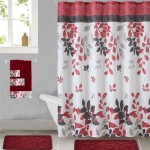How To Choose Curtain Color For Living Room
Curtains significantly impact a living room's aesthetic, influencing the perception of light, space, and overall ambiance. Selecting the right curtain color requires careful consideration of existing décor elements and desired mood.
Considering Existing Wall Colors: Wall color serves as the backdrop for the entire room. When choosing curtain colors, one should analyze the existing wall color. For rooms with neutral walls (e.g., white, beige, gray), a wider range of curtain colors becomes viable, offering opportunities for bolder choices or subtle enhancements. Rooms with bolder wall colors may benefit from curtains in neutral shades to balance the visual impact.
Harmonizing with Furniture and Upholstery: Furniture and upholstery play a crucial role in determining curtain color. One effective strategy involves selecting curtains that complement the dominant upholstery color. For example, if a sofa features a deep blue upholstery, curtains in a lighter shade of blue or a complementary color like beige or gray can create a cohesive look. Alternatively, one can opt for curtains that match a secondary color present in patterned upholstery.
The Role of Room Size and Lighting: Room dimensions and natural light availability significantly influence color choices. In smaller living rooms, lighter curtain colors can create an illusion of spaciousness by reflecting more light. Darker colors can make a room feel more intimate and cozy, but in a small space, they might feel overwhelming. In rooms with abundant natural light, bolder and darker curtain colors become more viable. Conversely, rooms with limited natural light often benefit from lighter, more translucent curtains that maximize light penetration.
Understanding the Impact of Different Color Families: Different color families evoke specific moods and atmospheres. Warm colors like reds, oranges, and yellows tend to create a sense of energy and vibrancy. Cool colors such as blues, greens, and purples promote a calming and serene atmosphere. Neutral colors like beige, gray, and white offer versatility and can easily adapt to various design styles.
Exploring the Effects of Patterns and Textures: Patterns and textures add another layer of complexity to curtain selection. Bold patterns can serve as a focal point in a room with otherwise simple décor. Subtle patterns can add visual interest without overwhelming the space. Texture also plays a role in light filtration and overall aesthetic. Linen curtains, for example, offer a relaxed, natural look, while velvet curtains contribute to a more luxurious ambiance.
Creating Contrast or Maintaining Cohesion: Deciding whether to create contrast or maintain cohesion with existing décor is a crucial step. Contrasting colors can add drama and visual interest, while cohesive colors foster a sense of harmony and tranquility. For instance, dark curtains against light walls create a strong contrast, while curtains in a similar color family as the walls promote a more unified look.
Utilizing the Color Wheel: The color wheel provides a valuable tool for understanding color relationships. Analogous colors, located next to each other on the color wheel, create a harmonious and balanced look. Complementary colors, situated opposite each other on the color wheel, offer a bolder, more contrasting aesthetic. Triadic colors, forming an equilateral triangle on the color wheel, provide a vibrant and dynamic color scheme.
Considering the Room's Purpose and Style: The living room's intended function and overall design style should influence curtain choices. A formal living room might benefit from elegant, floor-length curtains in a rich fabric like velvet or silk. A more casual living room might suit lighter, more informal curtains made from linen or cotton. The style of the room, whether traditional, modern, or eclectic, should also inform color and pattern choices.
Testing and Sampling: Before committing to a specific curtain color, testing and sampling are essential. Ordering fabric swatches or borrowing sample curtains allows one to observe how the color interacts with the existing décor and lighting conditions. This helps ensure that the chosen color achieves the desired effect within the specific context of the living room.
Considering Curtain Rods and Hardware: Curtain rods and hardware should complement the chosen curtain color and fabric. The rod's finish (e.g., brushed nickel, oil-rubbed bronze) and the style of finials should harmonize with the overall aesthetic. One should also consider the weight and fullness of the curtains when selecting appropriate hardware.
Long-Term Considerations: Curtains represent a significant investment, so considering long-term preferences is crucial. Opting for classic colors and timeless patterns can ensure that the curtains remain aesthetically pleasing for years to come. One should also consider the ease of cleaning and maintenance when selecting curtain fabrics.

10 Easy Tips On How To Choose Curtains For Living Room By Livspace

10 Easy Tips On How To Choose Curtains For Living Room By Livspace

How To Choose The Right Color Curtains For Your Home Deconovo Us

How To Choose Curtains For Your Living Room Curtain Library

10 Easy Tips On How To Choose Curtains For Living Room By Livspace

How To Choose The Right Curtain Color Loft Curtains

How To Choose Curtains For Your Living Room Curtain Library

How To Choose Curtains For Living Room Designcafe

10 Easy Tips On How To Choose Curtains For Living Room By Livspace

How To Choose Curtain Colors For Your Living Room Indoweave








